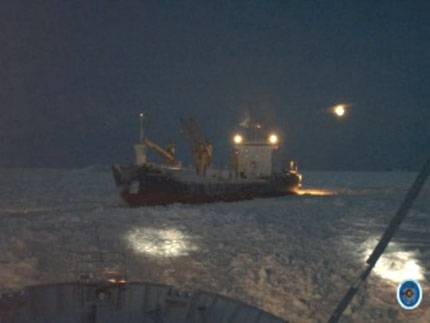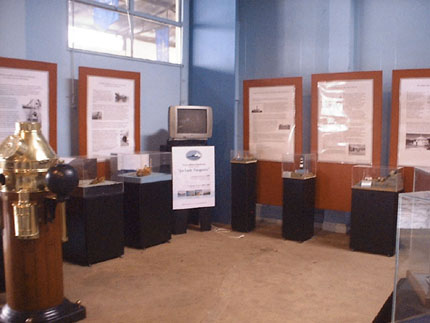OPERAtION "CRUZ DEL SUR"
RESCUE OF A SHIP TRAPPED IN THE ICE IN ANTARCTICA June 2002
The Argentine icebreaker "Almirante Irízar" set sail from the North Dock of the port of Buenos Aires to begin a mission classified as "high risk": to rescue the German ship Magdalena Oldendorff and its 107 Russian crew and scientists, which was trapped between the imposing blocks of Antarctic ice.
The Navy ship, 119.3 meters long and 25 meters wide, (see general characteristics) is capable of breaking through masses of ice seven meters thick. With nearly 176 crew members including meteorologists, glacier experts, a medical corps and an Army team, she covered approximately 8,000 kilometers. The first stop was in Bahía Blanca. There she supplied herself with the rest of the food, medicine and fuel.
In addition, two Sea King helicopters joined the rescue, facilitating access to the German ship "Magdalena Olendorff", flying the Liberian flag, to try to rescue 71 Russian scientists and 36 German, Indian, Filipino and Moldovan crew members.
The mission was considered "high risk and complexity" because it was not the time to go to Antarctica due to inclement weather (at that time it was recorded between 16 and 20 degrees below zero and decreasing to about 50 degrees below zero and winds of almost 70 kilometers per hour). The area had great climatic instability and a lot of cloudiness, strong waves, and an almost absolute lack of sunlight. The arrival in the area was estimated for July 8, depending on the "glaciometeorological" conditions.
The situation in Antarctica in July is complicated. It is a time of "growth of sea ice, the thickness of the ice increases downwards and there is strong compaction," explained the Navy expert, Manuel Picasso.
Just as of July 20 there will be one hour of sunlight per day plus two and a half hours of twilight. The luminosity will gradually increase and only on August 15 there will be about six hours of sunlight a day. This makes rescue efforts difficult and prevents meteorologists from having accurate weather information since satellites hardly transmit in these dark months - in fact, there is no history of a trip to these latitudes in the middle of winter.
This time, in order to carry out the rescue, according to the captain Raúl Benmuyán, the German company that owns the boat carried out negotiations with the Argentine Navy to request the help of Irízar. Finally, an agreement was reached, at no cost to the Argentine State. "The Germans will pay the initial expense, estimated at one million dollars, and to that will be added to the expenditure made for each of the days that they must stay in the place."
The German ship was rented by a Russian research institute and began its journey on April 12 when it left Cape Town, South Africa, for Antarctica, with supplies estimated until early July and fuel for about two more months. On June 11, when he was returning from a scientific mission at the Russian Antarctic base Novolazarevskaya, on the Antarctic edge, 3,000 kilometers in the direction of South Africa, he called for help when his crew discovered that they were trapped in a mass of ice of 92 km wide. Their communication systems are also damaged and they could only talk to a Russian base. Apparently, the crew began to feel the polar cold and began to ration food and fuel, fearing that the blockade would extend.
In the relief task, the Irízar had the help of the South African ship "Agulhas", which also left for Antarctica. The spokesperson for the South African Ministry of Environment and Tourism, Phindile Makwakwa, stated that the ship was advancing at eleven knots (about forty kilometers per hour) and that the water temperature was one degree below zero. According to the Argentine Navy, another 12 ships were also on the way.
The Argentine icebreaker is the only one of its kind in South America. It carried out 27 campaigns to Antarctica, including one in January 1989 when it reached a never-navigated southern latitude in the Weddell Sea (78 ° 21 '').
The Irízar carried two Sea King helicopters, because it was estimated that the approach to the "Magdalena Olendorff" would be difficult, since the ice barrier was too large to remove it. Despite everything, the Irízar arrived in Antarctica with sufficient supplies until October.
We cannot assure anything, we do not even know when we will be able to approach the Oldendorff. There is a risk that we ourselves will be trapped, "said Benmuyán within hours of leaving.
In any case, the modality of the mission was defined when the Irízar was near the place. Food was transported in helicopters and scientists were transferred to the icebreaker. It was sailed to the smallest possible distance - as long as the ice blocks did not exceed seven meters thick - to tow the ship to the clear water area.
The campaign was calculated to take two months: about 10 days of navigation between Buenos Aires and the Antarctic coasts of Princess Astrid (open waters closest to the ship); another five days - if the ice allowed it - to navigate 52 kilometers, plus the time required for the aid or towing of the German ship.
RETURN / DEPARTURE
Thursday, August 8, 2002. The icebreaker "Almirante Irízar" overcame a vast field of ice, so it sailed normally towards the port of Buenos Aires.
Sunday, August 18, 2002 The Irízar returned after its mission in Antarctica, after having set sail on June 25.
More than 200 vessels received the icebreaker "Almirante Irízar" when she entered the North Dock of the Port of Buenos Aires.
Admiral Irízar, during the operation called Southern Cross, which began on June 25 at the request of the German shipping company that owns the ship stranded in the Antarctic ice, managed to supply Oldendorff with fuel and food.
The Argentine vessel was commanded by the frigate captain Jorge Luis Tavecchia and had a crew of 176 people, including only one woman, an expert in glaciology. Among others, the fleet was made up of the commander of the Antarctic Naval Force, captain Raúl Benmuyal, and a representative of the shipyard of the German ship.
The Admiral Irízar, designed in Finland, had to cross more than 1,000 kilometers of ice to get out of the frozen mass, returning to Buenos Aires after 54 days of navigation, with 176 crew members.
In addition to the great reception with music bands and civil and military authorities, the exhibition "Argentina, one hundred years in Antarctica" was mounted on the pier, with the participation of the National Directorate of the Antarctic, Museum of Natural Sciences, Argentine Army, Fuerza Argentine Air Force, Argentine Navy, Naval Hydrography Service, Patagonia Ice Lady Ship, Ushuaia Maritime Museum and National Tourism Secretariat, among others.
Almost one hundred years ago, exactly in 1903, Lieutenant Julián Irízar, commanding the Argentine corvette Uruguay, rescued a Swedish ship from the ice. After that feat, he was christened the icebreaker in honor of the lieutenant. Perhaps this is a good sign for the crew of the stranded ship.
Returning from its campaign to Antarctica, in 1997, the icebreaker ARA Almirante Irizar, made a stopover in Isla de los Estados and participated in the recovery of the remains of the Lighthouse of the End of the World, whose replica is in the Maritime Museum of Ushuaia.
In January 2002, the ICEBREAKER A.R.A. "ADMIRAL IRIZAR" responded to INMARSAT's call from the passenger ship CLIPPER ADVENTURER, which requested maritime assistance since it was trapped in the ice. This Bahamian-flagged ship had sailed from Ushuaia with 105 passengers and 71 crew members. Consecutive to the call, the Icebreaker detached itself to the area, rescuing it and towing it until it encountered open waters to the northwest of the incident point.
























